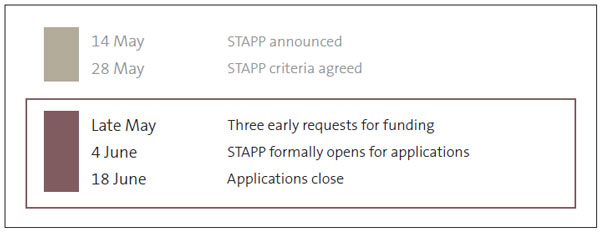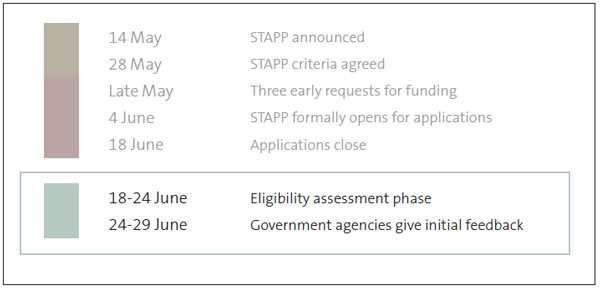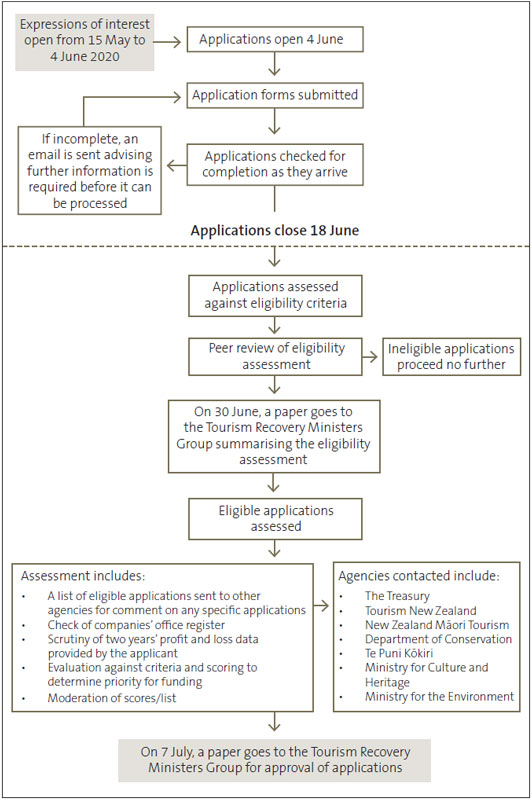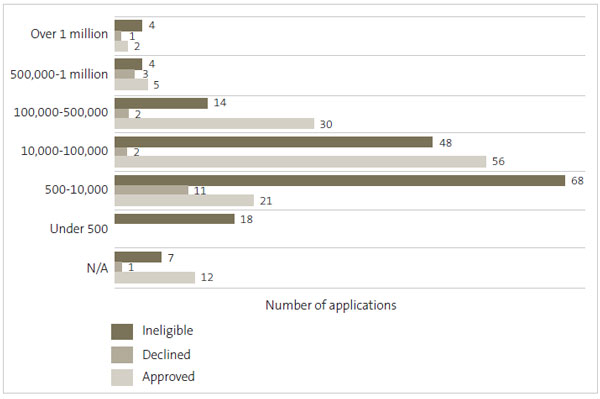Part 3: Early applications and eligibility assessment

3.1
In this Part, we outline:
- what happened with the three tourism businesses that applied for funding before STAPP started;
- how applications for STAPP funding were assessed; and
- our comments on the eligibility assessment process.
Three early applications
3.2
As mentioned in paragraph 2.12, Cabinet had directed the Ministry and the Treasury to provide ad hoc advice to the Tourism Recovery Ministers if there was a risk of losing strategic tourism assets before 1 June 2020.
3.3
Three tourism businesses sought support before STAPP officially started accepting applications. These businesses were:
- AJ Hackett Bungy New Zealand (on 27 May 2020);
- Discover Waitomo (on 28 May 2020); and
- Whale Watch Kaikōura (on 28 May 2020).
3.4
The three tourism businesses that asked for funding did not claim to be at risk of imminent financial failure. Two of the businesses proposed to hibernate for a period. One of the businesses was reportedly considering redundancies for up to 70% of its staff.
3.5
AJ Hackett Bungy New Zealand told the Ministry it needed funding so it could retain staff in roles that it considered essential. It did not confirm whether it had considered other funding options. The Ministry asked AJ Hackett Bungy New Zealand to complete a draft application form and provide two years of profit and loss statements.
3.6
Whale Watch Kaikōura told us it approached the Government with a partnership proposal: "the Kaikōura Pilot" on 28 April 2020. On 25 May 2020, Whale Watch Kaikōura was told that it needed to submit an application that aligned with the STAPP funding requirements. On 28 May 2020, it lodged an application for a $1.5 million grant to enable it to pivot to the Australasian market, meet overhead costs, and carry out repairs and maintenance.
3.7
Tourism Holdings Limited wrote to the Ministry seeking STAPP support for Discover Waitomo. Tourism Holdings Limited wanted funding "to bridge the gap" until tourists returned and prevent hibernating the business for 12 months (which would affect other local businesses) and continue to operate on a smaller scale.
The decisions to grant funding to the early applicants
3.8
The Tourism Recovery Ministers agreed to fund Whale Watch Kaikōura. We have not seen any evidence to identify what criteria the Tourism Recovery Ministers used when making this decision. We also did not see any advice from Ministry officials. On 10 June 2020, the Minister announced that Whale Watch Kaikōura had been provided $1.5 million grant funding.
3.9
On 2 June 2020, Ministry officials recommended that the Tourism Recovery Ministers approve grants to AJ Hackett Bungy New Zealand ($10.2 million over two years) and Discover Waitomo ($4 million over two years). The Tourism Recovery Ministers split the funding equally between grant and loan, which they considered would reduce any risks. This decision was a change from Ministry officials' original recommendation.
3.10
The Minister of Tourism announced the funding decision on 24 June 2020.14
Our comments on the early applications
3.11
These early funding decisions were made before STAPP was fully established, which meant they were managed differently from other STAPP applications. Decisions were made at speed, with advice and financial analysis that was more limited than other STAPP applications.
3.12
Whale Watch Kaikōura submitted a letter requesting government funding, along with a form it had created itself. We did not see any financial information supporting Whale Watch Kaikōura's request.
3.13
AJ Hackett Bungy New Zealand and Discover Waitomo submitted early versions of the STAPP application form and provided profit and loss statements. Neither business stated a risk of imminent financial failure but both indicated that there could be significant staff redundancies. Both businesses said that hibernation was an option. One business had contacted its bank about funding but the bank had not yet responded. The other indicated that it had a syndicated debt facility and access to capital markets for further funding.
3.14
Both AJ Hackett Bungy New Zealand and Discover Waitomo were funded the amount they said would enable them to operate at a minimal viability.
3.15
Overall, these three applicants were not subjected to the same level of financial analysis as the tourism businesses that applied once STAPP started receiving applications. It is not clear to us how the reasonableness of the funding requests was analysed or assessed.
Application process

3.16
Applications to STAPP were open from 4 to 18 June 2020. We note the intense time pressure that Ministry officials were under when assessing these applications. The application and assessment processes for STAPP were designed to provide funding quickly in an environment of uncertainty. They also required difficult prioritisation decisions.
3.17
We looked at the process for assessing whether applications for STAPP funding were eligible. We reviewed a sample of eligibility assessments to see how consistently they were applied. We expected to see alignment between the criteria required by the STAPP application form and the assessment criteria. We also expected to see that criteria was applied consistently.
All applications were checked for eligibility
3.18
By 18 June 2020, the Ministry had received 304 applications. Four further applications arrived within two hours of the deadline. These were accepted, bringing the total to 308.
3.19
A two-phase process was used to assess the applications: an eligibility assessment phase and then the full assessment phase (see Figure 3). We discuss the full assessment phase in Part 4. Officials worked long hours to keep to the short time frames set by the Tourism Recovery Ministers.
Figure 3
Strategic Tourism Assets Protection Programme application process

Source: Office of the Auditor-General
How was the eligibility assessment phase managed?
Eligibility checklist
3.20
A checklist was created to assess whether STAPP applications met eligibility requirements. This checklist relied on several fields from the application form where the applicants had self-declared that they met certain criteria (such as having exhausted all other avenues of support).
3.21
Other parts of the checklist required interpreting information provided in the application form about the nature of the applicant's business, visitor numbers, spill-over benefits to the region, and the financial impact of Covid-19.
3.22
The assessments were peer-reviewed before the results were collated and provided to other government agencies for feedback.
Input from other agencies
3.23
After completing its own assessments, the Ministry asked for feedback from government agencies with expertise in cultural, historic, and environmental areas. On 24 June 2020, the Ministry provided Tourism New Zealand, Te Puni Kōkiri, the Ministry for Culture and Heritage, the Ministry for the Environment, and the Department of Conservation with a complete list of all eligible and ineligible applicants.
3.24
Feedback from government agencies was due by Monday 29 June 2020.
3.25
There were some limitations to the feedback that was requested. The government agencies were given only the names of the tourism businesses and whether the Ministry had assessed them as eligible. This meant that the agencies relied on what they already knew about the tourism business. They did not have the benefit of understanding the factors that the Ministry relied on to reach its decisions.
3.26
The feedback from government agencies at the eligibility assessment phase is summarised in Figure 4.
Figure 4
Feedback from government agencies on eligibility assessment decisions
| Government agency | Feedback |
|---|---|
| Tourism New Zealand | Tourism New Zealand provided feedback on tourism businesses it considered to be top attractions and focused on applicants that had been deemed ineligible, providing additional advice about those businesses. This led to the Ministry changing five applications from ineligible to eligible. Tourism New Zealand considered there were potential inequities in how some types of tourism assets had been assessed and told the Ministry that it needed to have a good rationale for why some assessments resulted in different outcomes for applicants from industry segments (for example, air and water operators and accommodation). In response, the Ministry said that accommodation providers were considered a generic part of the tourism system and ineligible for STAPP funding unless there were strong cultural, historical, or environmental considerations. |
| Department of Conservation | The Department of Conservation advised which applicants held Department of Conservation concessions and commented that some applicants might also be eligible for Wildlife Institutions Relief funding. The Department of Conservation highlighted tourism operators that made significant contributions to, or provided support for, conservation activities. It disagreed with the assessment outcome of 19 applications because the justification for the suggested outcome for some was unclear. The Department of Conservation also questioned the consistency of the eligibility assessments for water, accommodation, and bungy operators. |
| The Ministry for Culture and Heritage | The Ministry for Culture and Heritage identified applications that it supported from an arts, culture, and heritage perspective. It did not disagree with any of the assessments. |
| Te Puni Kōkiri | Te Puni Kōkiri disagreed with 16 of the Ministry's eligibility decisions. Of the 16 eligibility assessments that Te Puni Kōkiri disagreed with, five were changed by Ministry officials from ineligible to eligible. |
| The Ministry for the Environment | The Ministry for the Environment chose not to comment on the eligibility assessment list, saying:[we] do not feel we can provide meaningful input into the initial eligibility of applications for STAPP funding as we have not seen the original applications or the eligibility assessment which means that we have no basis for making a judgment on eligibility for STAPP funding or for providing a judgement on MBIE's assessment of eligibility.The Ministry for the Environment recommended that support be directed towards tourism businesses with clear social economic, cultural, and environmental outcomes and that successful applicants commit to an environmental accreditation scheme. |
3.27
The feedback from agencies resulted in the Ministry amending its initial assessments so that six tourism businesses that had initially been deemed ineligible became eligible.
3.28
The Minister asked the Ministry to seek feedback from New Zealand Māori Tourism on the eligibility assessments. On 30 June 2020, the Ministry asked New Zealand Māori Tourism to complete a confidentiality agreement (but did not ask for declarations of conflict of interests). The Ministry gave New Zealand Māori Tourism a list of eligible and ineligible tourism businesses that the Ministry was providing the Tourism Recovery Ministers later that same day.
Moderation of eligibility assessments
3.29
After the Ministry had completed the eligibility assessments and received feedback from other agencies, it moderated the results.
Final decisions on application eligibility
3.30
The Ministry recommended to the Tourism Recovery Ministers that 146 applications should progress to a full assessment. It considered 118 applications to be ineligible. Reasons for deeming applications ineligible included:
- the business was a generic part of the tourism sector (such as accommodation, transport, or restaurants);
- the business was too small to be significant;
- the funding requested was out of scope (for example, requests for new capital investment or marketing); or
- in one case, a business requested funding for an asset that it did not own.
3.31
The Tourism Recovery Ministers approved the eligibility assessments on Thursday 2 July 2020. Before discussing the eligibility assessments, the Tourism Recovery Ministers were asked to declare conflicts of interest. The Minister of Tourism declared a conflict of interest with four tourism businesses and left the room when those businesses were discussed.
3.32
The Tourism Recovery Ministers required officials to provide more detail to support the decision-making for the full assessment process. They also asked the Ministry to implement random audits of successful applicants. On 9 July 2020, Ministry officials subsequently advised the Tourism Recovery Ministers that improved monitoring would be resource intensive and require additional resourcing. The Tourism Recovery Ministers agreed that monitoring would be informed by self-reporting by tourism businesses applying for STAPP funding.
3.33
Officials reminded the Tourism Recovery Ministers that since STAPP started, the wage subsidy scheme had been extended (it had been due to end on 9 June 2020). Department of Conservation concessions and a relief package for wildlife institutions and eco-sanctuaries had also been announced. This meant that the amount of funding requested by tourism businesses would need to be recalculated to take these other schemes into account. However, the Ministry advised that, due to the short time frames, it could not do this before the decision-making meeting.
Our comments on the eligibility assessment phase
3.34
From looking at the criteria, the applications, and the eligibility assessments, it was clear that some applications were not eligible for STAPP funding. Specific reasons for declining applications were not listed in the assessment sheet. As moderation process changes were entered directly into a spreadsheet, underlying reasons for decisions were not recorded.
3.35
For some tourism businesses applying for STAPP funding, we saw that the Ministry considered that the tourism aspect of their business was not sufficient for it to be considered as holding a strategic tourism asset. However, it is unclear to us what information Ministry officials relied on to form this view.
3.36
Some similar tourism businesses were treated differently on the basis that an asset needed to be the reason why tourists came to a region, rather than just a secondary activity. We are not sure what evidence informed an assessment that some tourism assets were not the reason people came to an area. From reviewing the eligibility assessment forms, it is not clear how Ministry officials came to their views on this. The eligibility checklist mostly consisted of "yes/no" tick boxes without supporting comment. This implies that there was a degree of comparison in making an assessment, but we are not sure how this was evidenced or tracked in the assessment process.
3.37
In our view, it seems that revenue and visitor numbers were key factors (see Figures 5 and 6). Tourism businesses with turnover in the $1 million to $10 million range and tourism businesses with visitor numbers between 10,000 and 100,000 were more likely to be deemed eligible.15
Figure 5
Application outcomes by annual revenue

Source: Data from the Ministry of Business, Innovation and Employment.
Figure 6
Application outcomes by annual visitor numbers

Source: Data from the Ministry of Business, Innovation and Employment.
3.38
Most venues were deemed ineligible for STAPP funding, but some council-owned venues were initially assessed as being eligible. This inconsistency was picked up at the full assessment phase, at which point they were deemed ineligible. One further venue was excluded late in the assessment process when it should have been deemed ineligible from the beginning.
14: See "Renowned tourism asset protected" (June 2020) at beehive.govt.nz. Subsequent to these decisions being made, the Government decided to extend the wage subsidy scheme.
15: For example, overall, ineligible aviation businesses tended to be from smaller operators with annual visitor numbers up to 6800 and revenue between $200,000 to $1 million. Businesses that were eligible for funding had visitor numbers up to 28,971 and business revenue from $1.2 million to $2.5 million at the lower end and between $8 million and $13 million at the upper end.

